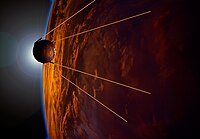The Metaphor Morphs: From Global Village to Global Theatre
 Sputnik 1
Sputnik 1
[1.2] Marshall McLuhan, one of the key founders of what we today call new media studies, first compared new media to performance in 1970, when he began to replace his 1962 term, global village, with a new term: global theater. In From Cliché to Archetype, McLuhan writes, “Since Sputnik [launched in 1957] put the globe in a ‘proscenium arch,’ and the global village has been transformed into a global theater, the result, quite literally, is the use of public space for ‘doing one’s thing'” (1970, p. 12). The global village has become the global theater (apparently in 1957, even before McLuhan first mentioned the global village—but let us not scrutinize McLuhan’s chronology too closely) because of the telecommunications networks that cross the world, making every place on the planet a potential performance space.
 proscenium arch
proscenium arch
[1.3] McLuhan’s replacement of village with theater as his preferred metaphor is read by John Tinnell (2011) as a commentary on live video transmission. Tinnell writes,
[1.4] Widespread televisual applications of satellite technology cultivated a tele-performative space, which…added an awareness that whatever took place in the presence of various electronic recording devices could be broadcast to and seen by large audiences all across the world, in real time and for all time. This awareness becomes a force of enculturation; one does not need to possess a video camera to be ontologically affected by the cultural (f)act of televisual recording and worldwide broadcasting.
[1.5] While I agree with Tinnell that McLuhan had global live television in mind when he declared that the world is now a theater, the implications of McLuhan’s global theater extend well beyond the medium of television.
[1.6] The Internet, more than television (indeed, the two are increasingly converging), is a public space for doing one’s thing, with participants generating their own content—putting on their own show, as it were. The Internet “turns the globe into a repertory theater to be programmed” by its participants (McLuhan, 1970, pp. 9–10). The Internet realizes McLuhan’s vision of a space that serves as a stage that is theoretically open to an infinite number of players, each doing their thing for others to witness, and thus contributing programming to the nonstop theater. McLuhan is even clearer in his prediction of a networked participatory culture in his 1972 book, written with Barrington Nevitt, Take Today: The Executive as Dropout. They write of
[1.7] the institution of a new kind of global theater, in which all men become actors and there are few spectators. The population of the world is both the cast and content of this new theater. The repertory of the theater consists of a perpetual happening,which can include the retrieval or replay of any previous happenings that men choose to experience. (p. 145)
[1.8] Thus is introduced the link between new media and theater, predicting future telecommunications platforms that will be open to participation by all (all who can gain access to the platforms and have the knowledge to use them, that is). From McLuhan and Nevitt’s phrase “perpetual happening,” and their statement that “all men become actors and there are few spectators,” we can see the influence of 1950s and 1960s performance culture—specifically, the famous Happenings by Allan Kaprow and others—on early 1970s new media theory. The connection that McLuhan perceives between performance and new media is interactivity, and McLuhan would not be the only new media theorist to see this resonance. In The New Media Reader, Noah Wardrip-Fruin and Nick Montfort write that “the idea of interaction associated with Happenings [in the 1950s and 1960s] was profoundly inspiring and has remained so for decades” because that idea “reflected and provoked a desire to break down distinctions between creator and audience—a desire and activity now central for many new media practitioners…The ‘Happenings’ are a touchstone for nearly every discussion of new media as it relates to interactivity in art” (2003, 83). (Source: http://tinyurl.com/p4hge5w )
References
McLuhan, Marshall. 1970. From Cliché to Archetype. New York: Viking Press, 1970.
McLuhan, Marshall, and Barrington Nevitt. 1972. Take Today: The Executive as Dropout. New York: Harcourt Brace Jovanovich.
Tinnell, John. 2011. “All the World’s a Link: The Global Theater of Mobile World Browsers.”Enculturation, no. 12. http://www.enculturation.net/all-the-worlds-a-link.
Wardrip-Fruin, Noah, and Nick Montfort, eds. 2003. The New Media Reader. Cambridge, MA: MIT Press.
For Allan Kaprow Happenings see http://tinyurl.com/p8z38yz .

The artist during the performance
Filed under: Academic, Articles, Commentary, Ideas, Media Ecology, New Media, Technology, Theatre | 2 Comments
Tags: academic, articles, communication, culture, global village, ideas, technology

This essay (After the Global Village) is more useful:
View at Medium.com
LikeLike
It probably is, Andrew. I know your paper, but didn’t have time to give it more than a cursory look. I’ll give it a proper reading when I have time. I do provide a link to your paper under blogosphere. Thanks. I hope you had a good trip home after Denver and Montreal…….Alex
LikeLike